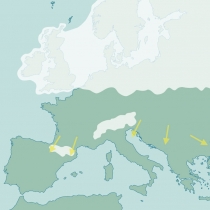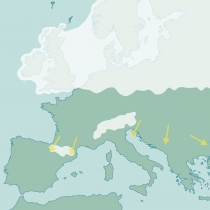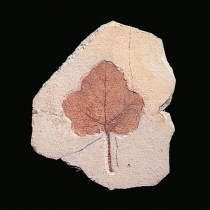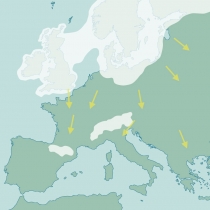The Origin of Vines
The Vitaceae family comprises 10 genera of tropical lianas which includes 3 Muscadinia subgenera, with at least 72 subspeciesof Vitis Tourn. with 38 chromosome pairs. Alleweldt und Dettweiler (1992) estimated 40,000 varieties of Vitis vinifera, of which more than 15,000 have been described. Portugal has 323 officially registered grapevine varieties (Portaria No. 428/2000).
The Vitaceae originated long before Man. These genera, with certain reservations, date back to the Mesozoic era, at the end of the Cretaceous period, roughly 65 million years ago.
Its development was influenced by an important change in our planet, the Continental Drift, which resulted in enormous change in landscapes. The creation of mountain ranges had climatic consequences, which in turn, had an influence on flora.
There is a lack of information on the Late Cretaceous period in Europe, which would correspond to the 1764 discovery of fossil remains in Maastricht, or to the age of the Vitis balbiana fossils exhibited at the Sorbonne in Paris.
Incidentally, it appears that the attribution of this species to the genus Vitis may not be confirmed. In his challenging study Schimper (1981: 578‑587) calls into question whether the fossil pieces from the Cretaceous period correspond to the genus Cissus, or the genera Cissites and Ampelophyllum, and wonders whether they had been attributed to the wrong family on the grounds of an insufficient amount of substance.
In the following period there occurred a development of gigantic proportions. Gradually, the Atlantic Ocean was formed. At first, the Super Continent remained as one, but finally America separated from Eurasia. Yet the phenomenon beforehand, of the formation of the Tethys Sea, from which the Mediterranean Sea developed, was far more dramatic.
At that time Portugal was almost completely covered in water and had a subtropical climate, as can be discerned from palaeontological data which have been collected in large part from the area between Aveiro and Taveira. Plant remains, molluscs, fish, turtles, crocodiles, some of the last dinosaurs (small ones), mammals, and other creatures were found.These data suggest that the climate here was similar to the modern day Everglades in Florida. In this regard it is hardly surprising that fossils of Vitaceae were found, which moreover share characteristics with those of prehistoric North America.
There is no doubt that tropical and subtropical life fell victim to a general worsening of the climate and its sharp slumps in temperature at the end of the Cretaceous period. When the temperature rose some plants and animals were able to survive in niche climates or escape by moving South, in those cases where no insurmountable obstacles such as estuaries, deserts, or mountains existed.
Compared to Europe which was geologically insulated by the Mediterranean Sea, the plants and animals in America experienced a less harsh migration and therefore their chances of survival were greater. This explains the higher degree of preservation of American species compared to those of Europe, particularly during the glaciations of the Quaternary period. Clearly, the higher number of Vitis species in North America and to a lesser extent in East Eurasia are testimony to the processes described above of better chances for migration and adaptation compared to Western Europe.
Disadvantageous climatic conditions are the principal cause for loss of species; thus for example, the dinosaurs who, with the exception of their flying species, disappeared.
Because of that, the new habitat conditions would be advantageous for other forms of life such as, for example, those able to maintain a constant body temperature, which is the case with mammals and birds. This scenario played out at the beginning of the Cenozoic era (Tertiary period) and continued until the Palaeocene epoch (until the Thanetian stage, some 55 million years ago); and must have therefore made the re‑emergence of the genus Vitis possible. It is supposed that the oldest fossils of this period were found in the Paris basin in the 19th century (Fig. 1).
According to Gignoux (1960):
– p. 513 – “Landénien: la transgression des sables de Bracheux” [a gulf formed that reached into the interior as far as Rheims].
– p. 514 – “… the flora leads one to assume if not a tropical climate, then at least a warm one…”
– p. 515 – “Sur les bords du golfe se sont déposées des formations continentales: les exemples les plus célèbres se voient dans la région de Reims; c’est le calcaire lacustre de Rilly, (…): des sources calcaires ont déposé sur la rive de ce lac les fameux travertins de Sézanne, avec des insectes, des feuilles et des fleurs moulées dans leurs moindres détails (Sassafras, Magnolias, Lierres [= hera], Vignes).” [“Continental formations were deposited on the shores of the Gulf. The most famous examples are seen in the region of Rheims; the lacustrine limestone of the sands of Rilly (…): limestone sources deposited the famous travertines of Sézanne on the shores of this lake, with insects, leaves and flower imprints in fine detail (Sassafras, Magnolia, Ivy [= hera] Vines”]
Another reference is found in the treatise by Boule & Piveteau (1935: 521‑522, fig. 863 R): “Vitis Sezannensis, ein paläozäner Weinberg in der Nähe von Reims” [“Vitis Sezannensis, a Palaeocene vineyard in the vicinity of Rheims”]. Amaral (1997: 27) refers to the fact that these wild grapevine varieties are also mentioned in the German and Swiss literature and share similarities with species in the South East of the United States of America, which once again corresponds to the logic described above. In other places in the Northern Hemisphere too, many fossils have been found which correspond to the Vitaceae. References are found in Greenland to the existence of Vitis species, which Schlimper (1891: 581) with fossil core evidence identifies as V. olriki Heer and V. arctica Heer.
Before the separation of the super‑continent Pangaea by the Atlantic the subtropical and tropical climate favour the expansion of species. Clearly, these possibilities for expansion, which the Vitis species also experience, was due to the absence of mammals. Certain phases of the great migration from the end of the Palaeocene to the Eocene have been successfully documented (Escarguel, 1999: 278):
– 1. circa 56.5 million years (Ma), from Asia to Europe and North America;
– 2. circa 56 Ma, from North America (and Asia) to Europe;
– 3. circa 55.5 Ma, from Europe to North America (This phenomenon has been substantiated using the methodology of the same author (Escarguel, ibid.) as having occurred about 54.1 million years ago during the age of Silveirinha, discussed below.)
After that came the irrevocable separation of the continent with the formation of the Atlantic.The land connection with what was to become North America was cut off shortly after that.
The distinctness of the discoveries in Portugal is of huge significance. Vitis was found in Silveirinha in the Lower Mondego, Portugal, from the middle Eocene era (Antunes, 2003; Pais, 2003). This is not surprising; the affinity of Western European vegetation today to each of the early forms in what is now North America was to be expected, just as this too has to be recognised with the prime examples of fauna. Conspicuous examples are the Hyracotherium of Silveirinha, the distant predecessor of the horse, which was also found in North America, and is another indication of a subtropical climate. As already mentioned, the link by land between the two continents broke off for good. Life on land evolved differently in Eurasia and North America. Some exceptions occurred because of migration from Asia. In the Eocene in Western Europe the climatic conditions continued to improve until it became a tropical climate. Vitis ampelophyllum in the vicinity of Verona in Italy (Amaral, ibid.: 27) is proof of this.
This is where there are significant deposits of fossils, including fish, which date back to the early and middle Eocene (the lower Lutetian, circa 49 million years ago). Very well‑preserved leaves are to be found, which have been attributed to the Ampelophyllum noeticum Massalongo species, of the Ampelidea family to which grapevines belong. (Sorbini, 1983: Tav. 105).
This species experienced a decline in the late Eocene (between 43 and 34 million years ago), which recovered in the following period, the Oligocene, particularly in the early Oligocene. From more recently than 34 Ma, fragments, mostly of seeds, were discovered at many Tertiary period archaeological sites. According to Schimper (1891: 581‑582), however, there is some doubt as to the precise chronological assignment of these fragments.
The slight improvement in climate in the late Oligocene (circa 27 to 23.5 million years ago) gave rise to the emergence of Vitis previnifera in Ardèche in France (Amaral ibid.: 28). In addition, it points to the presence of Vitis teutonica A. Brong. leaves (related to V. vulpina) in the late Oligocene at
Salzhausen in Germany. Seeds from the Oligocene were also found in Bovey Tracy in England. Taken together, they could well represent the most extensively distributed species over the longest period of time up until the late Miocene (Schimper, 1891: 581).
The Vitis genus was discovered at the time of the upper phase of the middle Miocene (circa 13 to 14 thousand years ago), of which the discovery in Póvoa de Santarém (Pais, 1978) is one example. Pais (1979, 1986) published the results of data collected in his palaeo‑ecological and palaeo‑ climatic research.
During the intermediate phase of the middle Miocene, and chronologically close to the Póvoa de Santarém deposits, another Vitaceae species was discovered in the Madrid lowlands,Ampelopsis cf. malvaeformis – cf. Marrón et al. (2004: 203).
There is, however, no documented basis for the presence of the Vitis genus in the Pliocene, a period which often yields few precisely‑dated fossil connections. The results of a more comprehensive fossil find at Rio Maior in Portugal which has been attributed to the Pliocene as well as the Pleistocene have not yet been published. The same problem is encountered with several Quaternary sites.
It is conceivable that the Vitis genus in our region could have disappeared during the hostile glaciations of this period. In Eurasia to the West of the Atlai mountains there developed a single species Vitis vinifera L., from which the subspecies V. (E.) vinifera silvestris, V. (E.), vinifera caucasica und V. (E.) vinifera sativa were derived. Schimper (1891: 582) wrote the following, “les restes fossiles quaternaires de V. vinifera L. sont des survivants de la flore tertiaire qui se relient à la flore actuelle” [The Quaternary fossil remains of V. vinifera L. are the survivors of Tertiary flora, which are related to the flora of today]
There are references to prehistoric species in France, Switzerland, Germany and Italy (Amaral, 1992). The Quaternary glaciations were extremely significant. They were accompanied by violent climatic and geographical changes, which called conditions of survival into question. The following charts show three phases and the palaeo‑ geographical consequences: two glaciations and one interglacial period, with the mainland and mountain ice caps shown in white (Inlandis glacier), land not covered in ice in red, and the sea in blue, as well as the migrations of flora and fauna, which are indicated with yellow arrows.
Grapevines almost disappeared from Central Europe during the Riss glaciation (~250 to 120 thousand years ago; they survived only in ecological niches with milder climates or micro climates. Branas (1974: 61) was of the opinion that, “Il est admissible que ceux‑ci [ecological niches] correspondent au pied de montagnes qui bordent la mer Mediterranée: Pyrenées, Cévennes, Alpes, Balkans, Caucase, etc…. Mais il est très hasardeux de rattacher les vignes cultivées à ces refuges» [It is possible that they (ecological niches) correspond to the foot of mountains which border the Mediterranean Sea: the Pyrenees, the Cévennes, the Alps, the Balkan Mountains, and the Caucasus Mountains, etc….But it is very risky to relate cultivated vines to these refuges.]
During the interglacial period which followed (between the Riss and Würm glaciations, (~120,000 to 100,000 years ago), the species spread out once again; this phenomenon repeated itself after the last Ice Age, particularly from the Transcaucasus, an area protected by the Caucasus Mountains.
From there, it spread to Mesopotamia, the North of Africa and the Balearic Islands. Amaral (1994: 29) conjectures that Homo sapiens of the Palaeolithic Era was still not a gatherer of the small bitter wild grapes of Vitis (E.) vinifera silvestris. The people of the Neolithic era were the first to recognise its value as food. Branas (1974: 62) mentioned that the concentrated occurrence of wild grapevines in Western Europe, Yugoslavia, North Africa and Russia (Crimea, Caucasia, Tashkent, and Turkmenistan). Negrul (1959, cited by Turkovíc, 1961: 84) also limited the presence of V. silvestris to the Mediterranean region, extending as far as the Black Sea, the Transcaucasus, the Kopet‑Dag area, Turkmenistan and Iran (the Ararat range).
Johnson (1989: 14) states, “But the oldest pips of cultivated vines so far discovered and carbon dated – at least to the satisfaction of their finders – were found in (then Soviet) Georgia, and belong to the period 7000‑5000 BC.”
It is possible that at that time wine had already been discovered.Evidence for this are the clay jugs in which the grapes or grape juice could have fermented on their own.The oldest containers found came from the Transcaucasus and were called Kwevri. Later, the Greeks called these same clay containers Phito, and the Romans, Dolium. The Portuguese “talhas” and “ânforas” of the same shape and using the same material are still in use today.
Vitis fossils are found in almost all countries of Central and Southern Europe. The first reference found in the Old Testament, “And Noah began to be an husbandman and planted a vineyard” (Genesis 9: 20) must date back to this period too.
Johnson (1989: 17) goes one step further in that he recognises the cultivated grapevine as a form of civilisation of the wild grapevine. The wild grapevine (V. silvestris) is dioecious, which means that it has both male and female plants. At first, however, Man selected only the female plants, because only the females bear fruit. Once the infertility of the monoculture was realised, selection of “Vitis sativa” began to be selected. This is the unusually hermaphroditic form of the wild grapevine which is self‑fertilised. Thus, the first cultivated Vitis vinifera grapevine came into being.
Turkovíc (1961: 81, 82) also established the difference between the subspecies Vitis vinifera ssp. sativa and V. vinifera ssp. silvestris based on dioecy. In addition, he differentiates them by the shape and size of the seeds, which are hardier and shorter than those of V. silvestris, whilst the leaves have an open petiolar sinus. V. silvestris also has less compact grapes and the berries are round, blue, and only occasionally white; the seed has a very fine, non prominent beak.
Branas (1974: 63) sees similarities between the morphology of wild vine varieties and cultivated varieties in a number of regions. In the Rhine region this is true of the Spätburgunder, or Pinot Noir, as it is in the Nevretvatal (Yugoslavia), the Kadarka, Blatina, etc., as well as the varieties in the Caucasus or near the Black Sea. In Portugal, the “numerical taxonomy” method made it possible to establish the close similarity between the regional Marufo vine variety and plants in the natural wild grapevine population in Castelo Branco (Dias, 2004: 6). The existence of wild grapevines in Spain was researched by Ocete Rubio (1999).
Diego Riera Núñez and Michael J. Walker, of the University of Murcia (1989: 205‑237, in Review of Palaeobotany and Palynology), refer to Clemente (1807: 143,153, 171‑173) who had already differentiated 5 forms of spontaneous Vitis (wild varieties).
As previously mentioned, to date there is no proof of the existence of Vitis either in the Pliocene or Pleistocene. Sizeable fluctuations in climatic conditions influenced its dissemination, which explains the lack of reliable evidence. Nevertheless, its survival in milder niche climates even during the Ice Age would have been possible.
The geographical location of Iberia, well protected by snow‑capped Pyrenees to the North, and subject to maritime influences (the Atlantic, and Mediterranean) is very similar to that of Georgia (latitude 41°‑39° N), Azerbaijan, and even the south of Turkmenistan (areas South of the Caucasus, the Kopt Dag with a maritime climate because of the Black Sea and the Caspian Sea. It therefore seems reasonable to assume that Vitis vinifera could also have survived in Iberia.
Climatic conditions changed with the advent of the Holocene (< 10,000 years BP, or “Before Present”, in accordance with the 1950 radiocarbon dating convention). Moreover, most of the evidence has not yet been proven according to scientific archaeological principles.
Maria‑Jose Iriate‑Chiapusso, University of the Basque Country (Vitoria‑Gasteiz) writes, “The earliest evidence of wild vines in Spain comes from the Quaternary. In the Gran Dolina de la Sierra de Atepuerca (Burgos) Vitis pollen was found (García‑Anton, 1989) dating to 780,000 BP (in the Middle to Lower Pleistocene, at the time of the Brunhes– Matuyama reversal). Evidence from the Middle Pleistocene also exists in the Fuente de Jumilla (Murcia). Seeds of Vitis silvestris (Montes 1992) were found dating to the Upper Palaeolithic.
Vitis pollen was also found in the Turbera del Padul (Granada), but some difficulties have been experienced in dating the material. Florschütz et al. (1971) have classified these findings as being from the beginning of the Upper Pleistocene before the Eemian interglacial period (pre‑ Würm glaciation).
Evidence of Vitis from the last interglacial period (Würm/ Weichsel) has been found in the most diverse places: carbonised vines at Abric Romaní (Anoia, Catalonia) dating to 70,000 BP (Burjachs, Julia 1994, Ethel, 2002) and (Buxó, Piqué, 2008); fossil grape seeds in Mediona I (Alt Penedès, Catalonia); and grapevine fossils dating to 30,000 BP in the Cueva de les Mallaetes [Les Mallaetes caves], in Valencia (Barx). Dupré (1988) writes that “… since the beginning of the Holocene (after the last Ice Age, our epoch), there are numerous proofs for the existence of Vitis silvestris…”.
Iriate‑Chiapusso does not know of any concrete evidence of the presence of grapevines on the Iberian Peninsula in the Neolithic Age, but she mentions that evidence of an alcoholic drink similar to beer in campaniform jugs dating to 5000 BC was found in a tomb at Sima (Mino de Medinaceli, Soria; Rojo et al., 2006). She supposes that from about 2000 BC, wine was brought to the Iberian Peninsula by seafaring peoples.
Diego Riera Núñez and Michael J. Walker, of the University of Murcia (1989: 205‑237, in Review of Palaeobotany and Palynology), provide detailed evidence Vitis silvestris on the Iberian Peninsula. In addition to the findings mentioned above, they have identified many others they have been able to reference: grape seeds dating to 10750 BP in Cueva de Caballo (Cartagena) in Murcia; pollen dating to 4800 BP from El Prado de Jumilla in Murcia; grape seeds dating to 4500‑4000 BP from Cueva del Calor at Cehegin; and stem fragments from the same period from Cueva del Monte of the Rambla de Libilla in Murcia.
 Fig. 3 – Circa 450,000 years ago, during the Mindel glaciation. The transformation of water into ice led to an increase in the surface covered by ice and to a fall in sea levels, creating new coastlines, and submerging entirely new areas elsewhere. There were long periods of cold. Tundras came into being, and the green areas retracted. Life forms requiring warmth, whether plants or animals were either pushed into the Mediterranean areas, or became extinct.
Fig. 3 – Circa 450,000 years ago, during the Mindel glaciation. The transformation of water into ice led to an increase in the surface covered by ice and to a fall in sea levels, creating new coastlines, and submerging entirely new areas elsewhere. There were long periods of cold. Tundras came into being, and the green areas retracted. Life forms requiring warmth, whether plants or animals were either pushed into the Mediterranean areas, or became extinct.
 Fig. 5 – In contrast to the glaciations, the climate in the interglacial periods was characterised by markedly higher temperatures, as this example of the Riss-Würm interglacial period 120,000 years ago shows.The icebergs withdrew considerably, and the sea rose, with the concomitant inundation of coastal areas.Plants and animals were able to spread out again in the North, which was covered with mixed forest once more.
Fig. 5 – In contrast to the glaciations, the climate in the interglacial periods was characterised by markedly higher temperatures, as this example of the Riss-Würm interglacial period 120,000 years ago shows.The icebergs withdrew considerably, and the sea rose, with the concomitant inundation of coastal areas.Plants and animals were able to spread out again in the North, which was covered with mixed forest once more.




